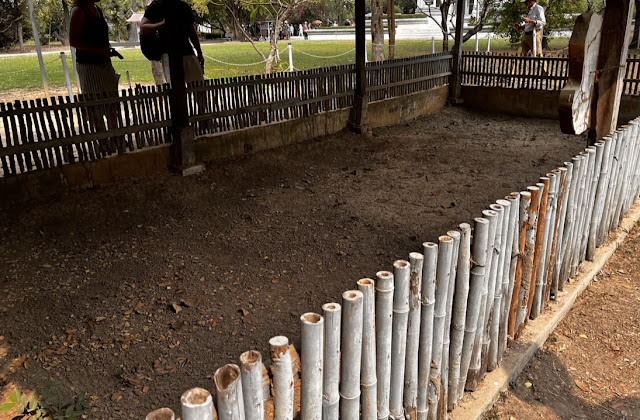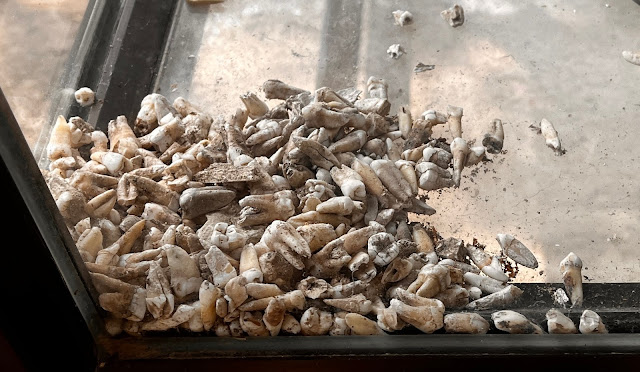This was a difficult day to absorb. Way more emotional than the DMZ Tour.
There are more than 20,000 mass killing fields in Cambodia. We visited the largest one. Again we were fortunate to have a man who has personal experience with these atrocities. His passion brought many of us to tears as he recalled the horrors of this war. And his hopes that in educating people, it will ensure that it will never happen again. From 1975-1979, the Khmer Rouge, a communist party, is responsible for over 2.5 million, men, women and children being tortured and killed.
This Field is called was Choeung Ek, and serves as a monument to all those who died – and those who survived. It is also an educational tool that could help us to ensure that history of Cambodia never repeats itself.
This commemorative monument greats you at the beginning of the tour.
A photo of the fields with another monument in the background.
Our Guide took us through the Field pointing out the markers, and what events happened there. Those sent to Choeung Ek made the 17km (11mi) journey crammed into the back of trucks.
and some days they could not kill all of them, so had to house them somewhere, out of sight.
These people were told they were going to meet their ‘King’ .. there are photos of children smiling as they left. Little did they know they were being trucked to a horrible death.
Once there, many were blindfolded and, ...in order to save ammunition, ...the executions were often carried out using improvised weapons: poison, smashed spades into their heads, sharpened bamboo sticks, hammers, machetes and axes. Our Guide showed us that even parts of trees were used.
Their bodies un-ceremoniously dumped into shallow graves and covered over with DDT.
Many of these mass graves were fenced off
There are walkways, but everywhere you looked on the soil, you could see bones, and fabric
Pieces of bones remaining after excavation in 1980. Each time it rains, more bones/fabric emerge.
They continue to collect bones, shoes ...
and teeth
This was particularly horrifying. Babies were torn from their Mother's arms,... what greater torture could you give a Mother. They killed children so they would not be able to grow up and seek revenge. Many bracelets and flowers have been placed here... i left mine...
This tree, fruit, and bark are extremely poisonous, and was also used to kill prisoners
This tree was used to hang loud speakers ... to cover the sound of victims being executed, from neighboring farms and villages. To think that this was all going on, and people didn't realize it... until it was too late .... I pray to God that this cannot happen in this Century !
This was the site of their Working Office
And there were 'rules' for the prisoners to follow. Note #6: "While getting lashes or electrification you should absolutely not scream or cry out". Many of the prisoners were 'spies or CIA' ... so was their reasoning for interrogation, torture, and death
It is thought that about 17,000 men, women and children were executed at this site. This Monument stands on the property.
It has 17 floors of skeleton heads, piled on top of each other, and lined up in rows. It can be viewed from all 4 sides.
After visiting this Killing Field, we had a tour of Prison S21. Once a school, it housed and killed between 14,000-17,000 Cambodians over the course of the 1975-1979 genocide war.
Men and women were interrogated and brutalized for 'belonging to the CIA, or foreign governments'. They loaded them into vehicles and took them to Prison S21 where they were tortured under the auspicious of their relationship to the CIA. I asked our Guide if any of the Guards actually believed they were spies… he flatly said ‘no’. They had been 'brain-washed' into believing they were the 'enemy' and needed to be destroyed. They were simply carrying out ‘orders’ to destroy the ‘enemy’.
I can't think of any other way to describe this tour, other than 'tactile'. There are 3 buildings of cells. You toured where walls were built in the classrooms to make actual prison cells.
In each building there were hundreds/thousands of 8x10 photos of prisoners: male, female, old, and especially the young, with eyes so expressive, i couldn't look at them without crying. Photos also of tortured and dead bodies. I asked why they took those photos, he said to prove to the superiors that they
were actually torturing and killing people. It was painful to see.
The 'beds', with a box to use as a toilet ... and shackle irons
Actual photos of bodies being shackled to the bed
With this notation
Blood splatters on the walls and ceiling, and carvings in the wall
places were bodies were found, blood stained.
There were only 12 survivors (4 of them children) of that prison.
We met one of the survivors, Chum Mey, on the left above, born in 1930. He was spared because of his skill as a mechanic. After 12 days/nights of torture, he was 'plucked' to repair typewriters used to record 'confessions'. At 93 yrs old, he spends part of each day at this Museum telling his story.
He has also written a book: SURVIVOR, The Triumph....etc. I think you can read this about him here:
Several of those responsible for this ‘state-sponsored’ Cambodian genocide were held on trial. Some died before the trial, some died in prison. There is only one still living, serving out his sentence. I can't help but wonder what he is thinking today..... does he have regrets? is he sorry? ... or does he stand by his belief that these people were spies, connected to the former government or foreign governments, and needed to be eliminated?
Our Guide's Mother was only 12 during this time. She escaped a working farm and returned 'home' to find no one. He said she never spoke another word. I share these gruesome details and photos with you; because our Guide was very serious as he looked at each of us in the eyes, and asked that we share this, in hopes that it will never happen again.
Cambodia remains one of the most landmined countries in the world. It's estimated that 4-6 million landmines were laid in the country, ultimately making it home to the world's highest ratio of mine-amputees per capita. People are still injured each year from the unknown number of landmines which remain scattered in the countryside's roads and fields.
It was an emotionally exhausting day. I hope I was able to convey his wishes to you all.
































No comments:
Post a Comment